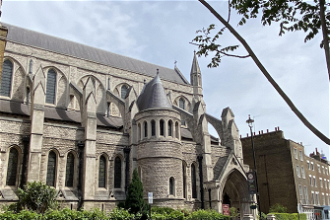Encounters with the early British church - Part One

Nick Mayhew Smith, author of the new book Britain’s Holiest Places, uncovered a goldmine of Christian heritage during his travels across the country. In this two-part series, he introduces some of the oldest sites that touch the traditions of our ancestors.
Christian history goes back a long way in Britain – nearly 2,000 years if legends about Joseph of Arimathea visiting Glastonbury are to be believed. Six years ago I set out to track down the traces of this immense and fascinating heritage. My journey turned into an amazing catalogue of wonders, from illuminating early artworks to remote and misty mountains, icy holy pools to enchanting ancient churches.
As the surprises and delights mounted with every visit, what struck me consistently was how much these sites are now being put to use again.
It is a little remarked fact that Britain’s sacred sites have undergone a quiet revival in recent decades. Nearly everywhere I visited had signs of active veneration. At the very few that still resided in the ‘neglected’ category I managed my own devotions, shivering into a long-forgotten holy spring or fighting through brambles into the ruins of a church. The marks of time and the ire of reformers have scarred our landscape, but failed to eradicate its spiritual worth.
The result of my research is a guide to more than 500 places where anyone can go and immerse themselves in the timeless faith and traditions of unnumbered believers before us. We are lucky enough to have some of the earliest and most moving Christian artefacts and experiences to be found anywhere in the world.
Below is a small selection of what I believe to be the earliest encounters of their type to be found. Our history is still being rediscovered, and others may have their own opinions on these categories and others that tell a similar story.
Oldest icon
Westminster Retable, Westminster Abbey, London
Few icons escaped the reforming fires of the 16th and 17th centuries. And yet at the political and ceremonial heart of the Church of England, a delicate iconographic panel painting has somehow survived. It is called the Westminster Retable, a technical term used to describe a screen that sits behind an altar. Just enough of its beautifully painted detail survives, including most of the face of Christ himself in the centre, flanked by the Blessed Virgin and St John the Evangelist. The panel is three metres long, and also includes scenes from four of Christ’s miracles and the fragmentary figure of St Peter on the far left, patron saint of Westminster Abbey and much else besides.
The Retable is displayed in the abbey’s museum, which is entered through the main abbey buildings. For ticket prices and visiting times see www.westminster-abbey.org
Oldest Christian painting
Orantes mural at Lullingstone Roman Villa, Kent
As recently as 1939 a team of archaeologists unearthed an extraordinary section of wall painting in the ruins of a Roman villa in Kent. Believed to be the decoration of a house chapel dating from the 4th century, this long panel shows six priests standing at prayer, their hands raised and facing the viewer in a position known as ‘Orantes’. The gesture is still used today, and Lullingstone has the oldest known depiction of such a liturgical device to be found anywhere in the world.
You can see the restored section of wall in Room 49 of the British Museum, where it is permanently on display. Lullingstone Roman Villa is also a visitor attraction, just a short drive from the M25. It is open most of the year; for visitor details see www.english-heritage.org.uk/daysout/properties/lullingstone-roman-villa
Oldest monastery site
St Ninian’s Priory, Whithorn, Dumfries & Galloway
Murky medieval claims are made about other possible monastic sites, but St Ninian’s Priory has both recorded history and ancient Christian artefacts to back up its case for being the oldest. The Venerable Bede describes it as the foundation of an early missionary called St Ninian, who operated at the very end of the Roman empire, around the year 400. He set up this pioneering outpost of faith in what is now Whithorn, a remote place even today, yet fully deserving of a pilgrim’s efforts. Ruins of early stone buildings can be seen, possibly the site of St Ninian’s own church, while an adjacent museum has the oldest Christian inscription in Scotland, the Latinus Stone, a grave marker dating from about 450.
Britain's Holiest Places by Nick Mayhew Smith, is published by Lifestyle Press ISBN 9780954476748 - available on Amazon, Waterstones and most bookshops.



















